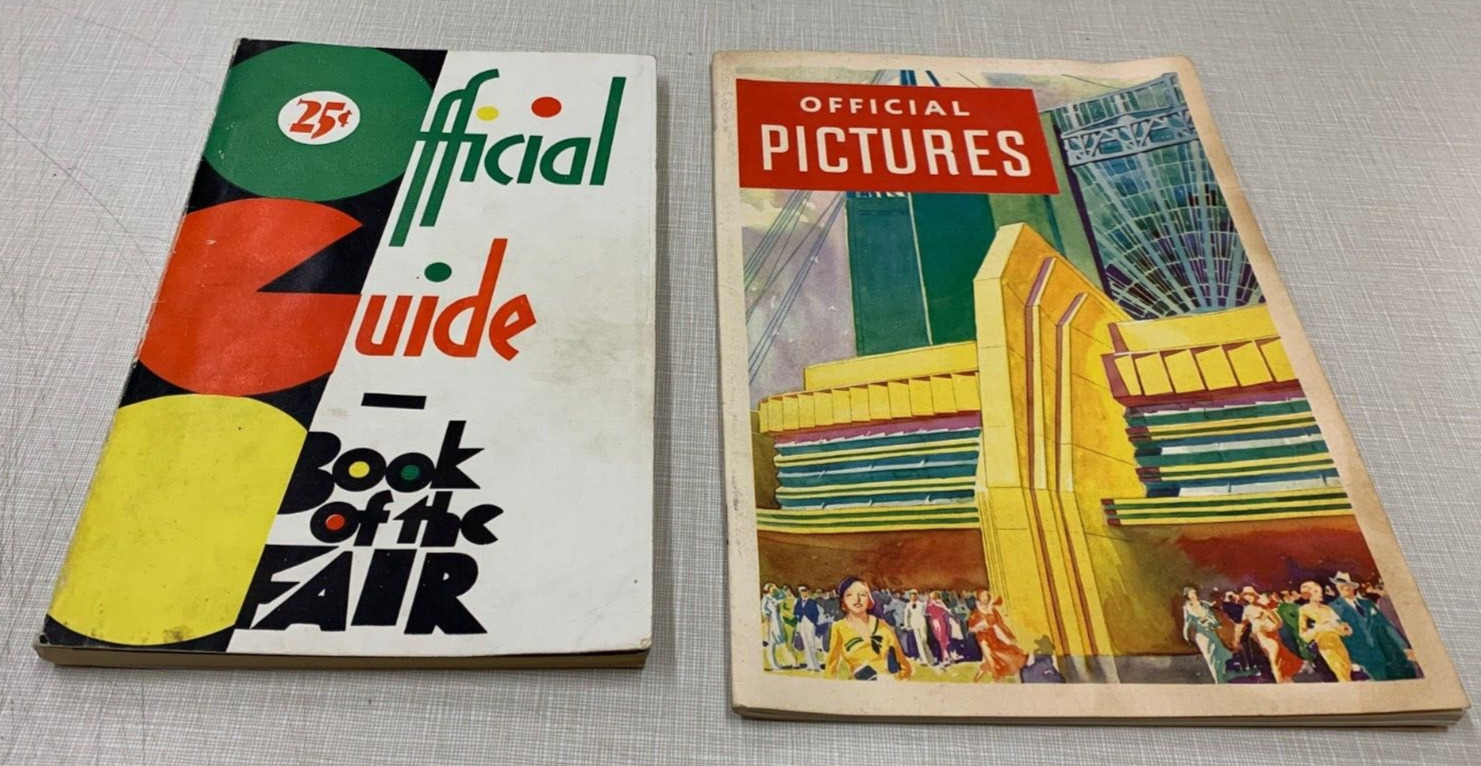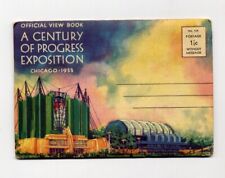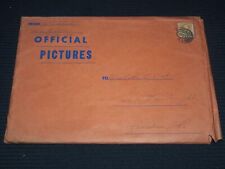1933 Official Guide Book and Pictures of the Chicago World's Fair Art Deco For Sale

When you click on links to various merchants on this site and make a purchase, this can result in this site earning a commission. Affiliate programs and affiliations include, but are not limited to, the eBay Partner Network.
1933 Official Guide Book and Pictures of the Chicago World's Fair Art Deco:
$49.99
Two Rare Pieces from the 1933 World's FairOfficial guide: book of the Fair 1933. [Foreword by Rufus C. Dawes]; Pure Oil pathfinder map of A Century of Progress. . . .[CENTURY OF PROGRESS -- ART DECO].Published by A Century of Progress, Administration Building; The Pure Oil Company,, Chicago, IL:, 1933
Two pieces. 1st - 8vo. 194 pp. Four colour frontisp. insert for Art Deco Firestone building, 1 large folding map of the Exposition, photo & text illustrations throughout. Colour-illustrated softcovers, Art Deco lettering front cover 2nd - 8vo. 4 x 9 in. which opens leporello-accordion style into 24 x 9 in. map of the Exposition on verso, printed in blue & red, photo illustrations on recto, Art Deco styled cover art (slight age toning), still NF. First editions
Official World's Fair Pictures of a Century of Progress Exposition 1933by Kaufmann & Fabry Co. (Official Photographers) (Photographer)
A Century of Progress International Exposition, also known as the Chicago World's Fair, was a world's fair held in the city of Chicago, Illinois, United States, from 1933 to 1934. The fair, registered under the Bureau International des Expositions (BIE), celebrated the city's centennial. Designed largely in Art Deco style, the theme of the fair was technological innovation, and its motto was "Science Finds, Industry Applies, Man Conforms", trumpeting the message that science and American life were wedded.[1] Its architectural symbol was the Sky Ride, a transporter bridge perpendicular to the shore on which one could ride from one side of the fair to the other.One description of the fair noted that the world, "then still mired in the malaise of the Great Depression, could glimpse a happier not-too-distant future, all driven by innovation in science and technology". Fair visitors saw the latest wonders in rail travel, automobiles, architecture and even cigarette-smoking robots.[2] The exposition "emphasized technology and progress, a utopia, or perfect world, founded on democracy and manufacturing."[3]ContextTicket for the opening day ceremonies at Soldier FieldA Century of Progress was organized as an Illinois nonprofit corporation in January 1928 for the purpose of planning and hosting a World's Fair in Chicago in 1934. City officials designated three and a half miles of newly reclaimed land along the shore of Lake Michigan between 12th and 39th streets on the Near South Side for the fairgrounds.[4] Held on a 427 acres (1.73 km2) portion of Burnham Park, the $37,500,000 exposition was formally opened on May 27, 1933, by U.S. Postmaster General James Farley at a four-hour ceremony at Soldier Field.[5][6] The fair's opening night began with a nod to the heavens. Lights were automatically activated when the rays of the star Arcturus were detected. The star was chosen as its light had started its journey at about the time of the previous Chicago world's fair—the World's Columbian Exposition—in 1893.[7] The rays were focused on photoelectric cells in a series of astronomical observatories and then transformed into electrical energy which was transmitted to Chicago.[8]ExhibitsA Century of Progress International Exposition - map drawn by Tony SargThe fair buildings were multi-colored, to create a "Rainbow City" as compared to the "White City" of Chicago's earlier World's Columbian Exposition. The buildings generally followed Moderne architecture in contrast to the neoclassical themes used at the 1893 fair. One famous feature of the fair were the performances of fan dancer Sally Rand. Hal Pearl then known as "Chicago's Youngest Organist" and later "The King of the Organ" was the official organist of the fair. Other popular exhibits were the various auto manufacturers, the Midway (filled with nightclubs such as the Old Morocco, where future stars Judy Garland, the Cook Family Singers, and the Andrews Sisters performed), and a recreation of important scenes from Chicago's history. The fair also contained exhibits that would seem shocking to modern audiences, including offensive portrayals of African Americans, a "Midget City" complete with "sixty Lilliputians",[9] and an exhibition of incubators containing real babies.[10]The fair included an exhibit on the history of Chicago. In the planning stages, several African American groups from the city's newly growing population campaigned for Jean Baptiste Point du Sable to be honored at the fair.[11] At the time, few Chicagoans had even heard of Point du Sable, and the fair's organizers presented the 1803 construction of Fort Dearborn as the city's historical beginning. The campaign was successful, and a replica of Point du Sable's cabin was presented as part of the "background of the history of Chicago".[11] Also on display was the "Lincoln Group" of reconstructions of buildings associated with the biography of Abraham Lincoln, including his birth cabin, the Lincoln-Berry General Store, the Chicago Wigwam (in reduced scale), and the Rutledge Tavern which served as a restaurant.Admiral Byrd's polar expedition ship the City of New York was visited by President Franklin D. Roosevelt when he came to the fair on October 2, 1933. The City was on show for the full length of the exhibition.[12]Cover carried on the Graf Zeppelin from 1933 Century of Progress Exposition franked with C-18 US Air Mail stamp issued for the airship's visit.One of the highlights of the 1933 World's Fair was the arrival of the German airship Graf Zeppelin on October 26, 1933. After circling Lake Michigan near the exposition for two hours, Commander Hugo Eckener landed the 776-foot airship at the nearby Curtiss-Wright Airport in Glenview. It remained on the ground for twenty-five minutes (from 1 to 1:25 pm)[13] then took off ahead of an approaching weather front, bound for Akron, Ohio.The "dream cars" which American automobile manufacturers exhibited at the fair included Rollston bodywork on a Duesenberg chassis, and was called the Twenty Grand ultra-luxury sedan; Cadillac's introduction of its V-16 limousine; Nash's exhibit had a variation on the vertical (i.e., paternoster lift) parking garage—all the cars were new Nashes; Lincoln presented its rear-engined "concept car" precursor to the Lincoln-Zephyr, which went on the market in 1936 with a front engine; Pierce-Arrow presented its modernistic Pierce Silver Arrow for which it used the byline "Suddenly it's 1940!" But it was Packard which won the best of show with the reintroduction of the Packard Twelve.The passengers, including "Zeph" the burro, that rode the Zephyr on the "Dawn-to-Dusk Dash" gather for a group photo in front of the train after arriving in Chicago on May 26, 1934.An enduring exhibit was the 1933 Homes of Tomorrow Exhibition that demonstrated modern home convenience and creative practical new building materials and techniques with twelve model homes sponsored by several corporations affiliated with home decor and construction.Electrical Building at night, by William Mark YoungMarine artist Hilda Goldblatt Gorenstein painted twelve murals for the Navy's exhibit in the Federal Building for the fair. The frieze was composed of twelve murals depicting the influence of sea power on America, beginning with the settlement of Jamestown, Virginia, in 1607 when sea power first reached America and carrying through World War I.[14] Another set of murals, painted for the Ohio State Exhibit by William Mark Young, was relocated afterwards to the Ohio Statehouse.[15][16] Young also painted scenes of the exhibition buildings.The first Major League Baseball All-Star Game was held at Comiskey Park (home of the Chicago White Sox) in conjunction with the fair.Frank Buck souvenir badgeIn May 1934, the Union Pacific Railroad exhibited its first streamlined train, the M-10000, and the Chicago, Burlington and Quincy Railroad its famous Zephyr which, on May 26, made a record-breaking dawn-to-dusk run from Denver, Colorado, to Chicago in 13 hours and 5 minutes, called the "Dawn-to-Dusk Dash". To cap its record-breaking speed run, the Zephyr arrived dramatically on-stage at the fair's "Wings of a Century" transportation pageant.[17] The two trains launched an era of industrial streamlining.[18] Both trains later went into successful revenue service, the Union Pacific's as the City of Salina, and the Burlington Zephyr as the first Pioneer Zephyr.[19] The Zephyr is now on exhibit at Chicago's Museum of Science and Industry.[20]Frank Buck furnished a wild animal exhibit, Frank Buck's Jungle Camp. Over two million people visited Buck's reproduction of the camp he and his native assistants lived in while collecting animals in Asia. After the fair closed, Buck moved the camp to a compound he had created at Amityville, New York.[21]Panoramic view of the 1933 Century of Progress World's FairArchitectureAhlberg Bearing Company pavilion at Century of ProgressPlanning for the design of the Exposition began over five years prior to Opening Day.[22] According to an official resolution, decisions regarding the site layout and the architectural style of the exposition were relegated to an architectural commission, which was led by Paul Cret and Raymond Hood.[23] Local architects on the committee included Edward Bennett, John Holabird, and Hubert Burnham. Frank Lloyd Wright was specifically left off the commission due to his inability to work well with others, but did go on to produce three conceptual schemes for the fair.[24][25] Members of this committee ended up designing most of the large, thematic exhibition pavilions.[26]From the beginning, the commission members shared a belief that the buildings should not reinterpret past architectural forms – as had been done at earlier fairs, such as Chicago's 1893 World's Columbian Exposition—but should instead reflect new, modern ideas, as well as suggest future architectural developments.[27] Because the fairgrounds was on new man-made land that was owned by the state and not the city, the land was initially free from Chicago's strict building codes, which allowed the architects to explore new materials and building techniques.[28] This allowed the design and construction of a wide array of experimental buildings, that eventually included large general exhibition halls, such as the Hall of Science (Paul Cret) and the Federal Building (Bennet, Burnham, and Holabird); corporate pavilions, including the General Motors Building (Albert Kahn) and the Sears Pavilion (Nimmons, Carr, and Wright); futuristic model houses, most popular was the twelve-sided House of Tomorrow (George Frederick Keck); as well as progressive foreign pavilions, including the Italian Pavilion (Mario de Renzi and Adalberto Libera); and historic and ethnic entertainment venues, such as the Belgian Village (Burnham Brothers with Alfons De Rijdt),[29] and the Streets of Paris (Andrew Rebori and John W. Root) where fan dancer Sally Rand performed.[30] These buildings were constructed out of five-ply Douglas fir plywood, ribbed-metal siding, and prefabricated boards such as Masonite, Sheetrock, Maizewood, as well as other new man-made materials.[31] The exhibited buildings were windowless (but cheerfully lighted) buildings.[32] Structural advances also filled the fairgrounds. These included the earliest catenary roof constructed in the United States, which roofed the dome of the Travel and Transport Building (Bennet, Burnham and Holabird) and the first thin shell concrete roof in the United States, on the small, multi-vaulted Brook Hill Farm Dairy built for the 1934 season of the fair.

Related Items:
Vintage 1933 Official View Book Mailer Century Progress Worlds Fair Chicago 1933
$14.00
1933 Official Guide Book and Pictures of the Chicago World's Fair Art Deco
$49.99
1933 OFFICIAL PICTURES & ENVELOPE - CENTURY OF PROGRESS - CHICAGO FAIR - J 8024
$75.00



